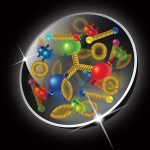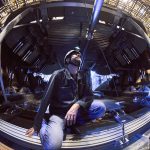From CERN, June 15, 2021: A new study shows a class of new unknown particles that could account for the muon’s magnetism, known as leptoquarks, also affects the Higgs boson’s transformation into muons.
quarks
From Huxiu.com, March 15, 2021: Fermilab’s SeaQuest experiment is hailed for discovering a “sea” of quarks surging inside the proton.
From NewScientist, March 8, 2021: The recent experiment results of asymmetry in protons published in Nature calling out the new research used to improve measurement techniques from Fermilab’s SeaQuest detector.
From the Science of the Francis Mule, March 1, 2021: Scientists at Fermilab and Argonne publish new results from SeaQuest experiment showing the asymmetry of protons.
From Reccom Magazine, Feb. 26, 2021: Chuck Brown of the Fermilab SeaQuest research team is quoted in this piece on the sea of quarks inside the proton. The article discusses Fermilab’s contributions to the SeaQuest and NuSea experiments.
From Los Alamos Laboratory News, Feb. 24, 2021: The E-906/SeaQuest experiment, hosted by Fermilab, has produced results that are the opposite of what had previously been understood about proton structure and the dynamics of strong interacting antiquarks and gluons.
Protons are built from three quarks — two “up” quarks and one “down” quark. But they also contain a roiling sea of transient quarks and antiquarks that fluctuate into existence before swiftly annihilating one another. At the Fermilab-hosted SeaQuest experiment, researchers report that that lopsidedness persists in a realm of previously unexplored quark momenta.
From Forbes, Feb. 17, 2021: Fermilab scientist Don Lincoln contextualizes the accomplishment of researchers working at the Japan Proton Accelerator Research Complex, or J-PARC. They have made an atomic nucleus that contains an unstable particle called the hyperon, or cascade particle. This could help in understanding neutron stars.
Matter and antimatter particles can behave differently, but where these differences show up is still a puzzle. Scientists on the LHCb experiment at the Large Hadron Collider study much more subtle differences between matter particles and their antimatter equivalents. A recent analysis allowed them to revisit an old mystery — an asymmetry between asymmetries.


